Container Security Market Size
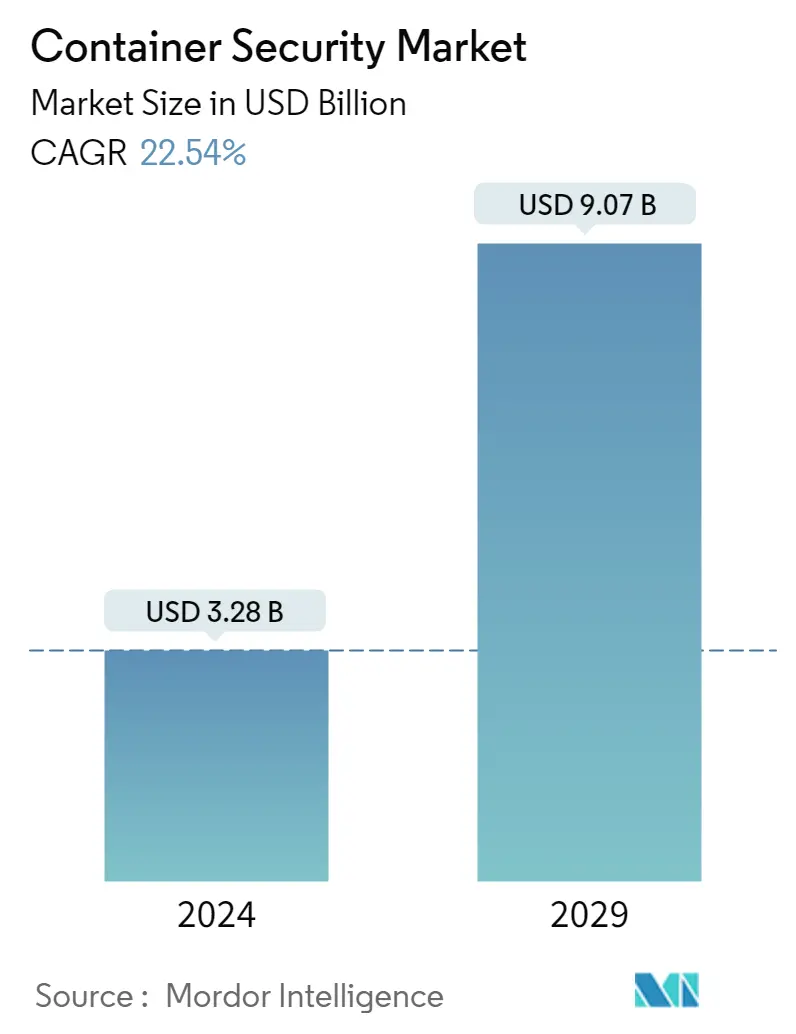
| Study Period | 2019 - 2029 |
| Market Size (2024) | USD 3.28 Billion |
| Market Size (2029) | USD 9.07 Billion |
| CAGR (2024 - 2029) | 22.54 % |
| Fastest Growing Market | Asia-Pacific |
| Largest Market | North America |
Major Players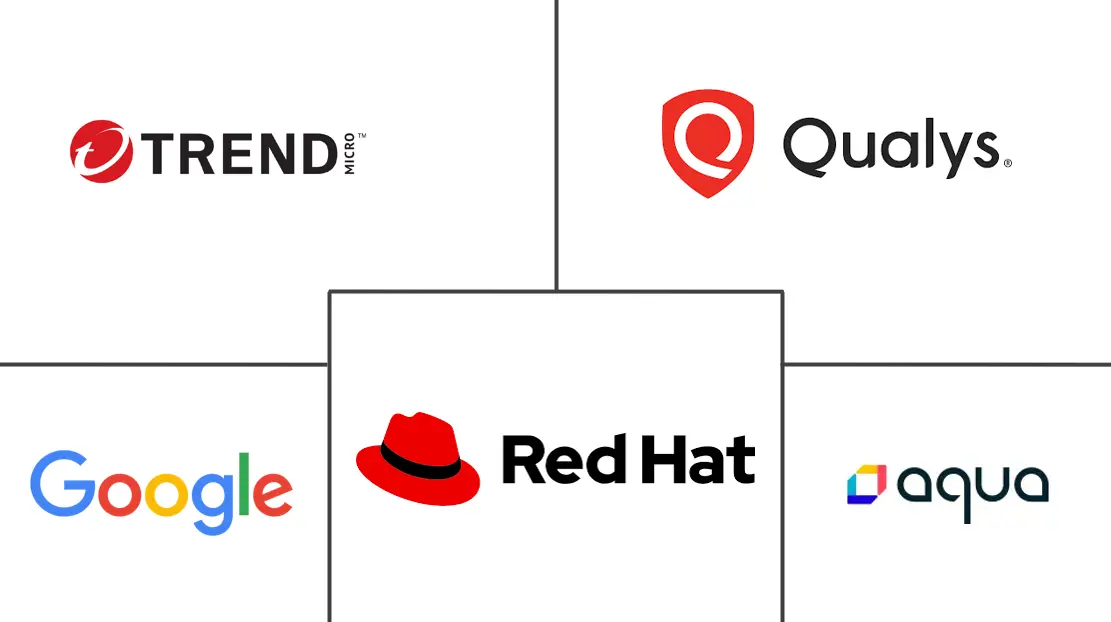
*Disclaimer: Major Players sorted in no particular order |
Container Security Market Analysis
The Container Security Market size is estimated at USD 3.28 billion in 2024, and is expected to reach USD 9.07 billion by 2029, growing at a CAGR of 22.54% during the forecast period (2024-2029).
Due to increased cybersecurity efforts to promote container security platforms globally and rising susceptibility, the container security market is anticipated to have a noticeable expansion over the projected period. Additionally, the development of the container security market study is expected to present lucrative prospects due to the popularity of microservices and the widespread use of digital transformation in businesses.
- The use of containers at the corporate level and the volume of application workloads running on them would significantly increase the acceptability of container security solutions. As nations in the region concentrate on transforming their outdated IT infrastructures into contemporary ones, containers as a service have been widely employed to virtualize huge quantities of workloads. They play a critical role in accelerating this change.
- Various enterprises have begun embracing technological advancements in order to automate their business processes and provide customer-centric services, realizing that immediate response, swift business decisions, and customer satisfaction are essential features needed to expand the business, generate more revenue, and ensure the desired outcome.
- Immediate response, quick business decisions, and customer satisfaction are some of the significant features needed to expand the business, generate more revenue, and ensure the desired outcome across the market.
- Ongoing collaboration among applications in the container and deployment of multiple applications across the open-source software development platform helps improve platform portability, enhance traceability of data, utilize entirely, and reallocate a container with minimal loss of data in case of an emergency, and is expected to fuel the market growth across the emerging economies.
- However, the market's expansion is constrained by SMEs' inadequate security budgets and consumers' lack of awareness of container technology and security. Additionally, operational difficulties, a lack of competent labor, and a lack of technological experience would hinder market expansion.
- Further, the COVID-19 epidemic positively impacted the market with the increased use of cloud-based cybersecurity tools for analyzing and countering cyberattacks. As work-from-home initiatives gained popularity, there was a rising need for these services. Additionally, the rise in demand for computer applications across the world's prominent businesses and increased demand for cybersecurity solutions within the government fueled market expansion during COVID-19.
Container Security Market Trends
Rising Adoption of the Hybrid Cloud Technology Applications may Drive the Market Growth
- The adoption of hybrid clouds is becoming increasingly essential for businesses that want to update their workloads and apps. These businesses have streamlined their operating procedures and increased corporate scalability as a result of their decision to bridge the gap between on-premises and cloud-based infrastructures.
- The usage of containerization technology can be crucial to the firm's profitability, whether or not it has chosen a hybrid cloud strategy. When used in a hybrid cloud context, containers would considerably enhance application performance, save operating costs, and expedite DevOps procedures. They also increase productivity when creating more extensive applications.
- Organizations require security that functions consistently regardless of where workloads are placed since hybrid models are still the preferred strategy. Kubernetes-native security strategies may enable environment-independent controls for both on-premises and cloud installations.
- According to Red Hat, the most prevalent method for executing containerized apps in big businesses was identified as hybrid cloud deployments. Whatever the location of the deployment of the workloads, these hybrid models require consistent security and compliance. In a state of Kubernetes security report 2022, Red Hat OpenShift is the management tool of choice for Kubernetes and containers, with 50% adoption among the 42% of respondents that employ a hybrid cloud deployment architecture. The utilization of Red Hat OpenShift increased by 13% from the previous year.
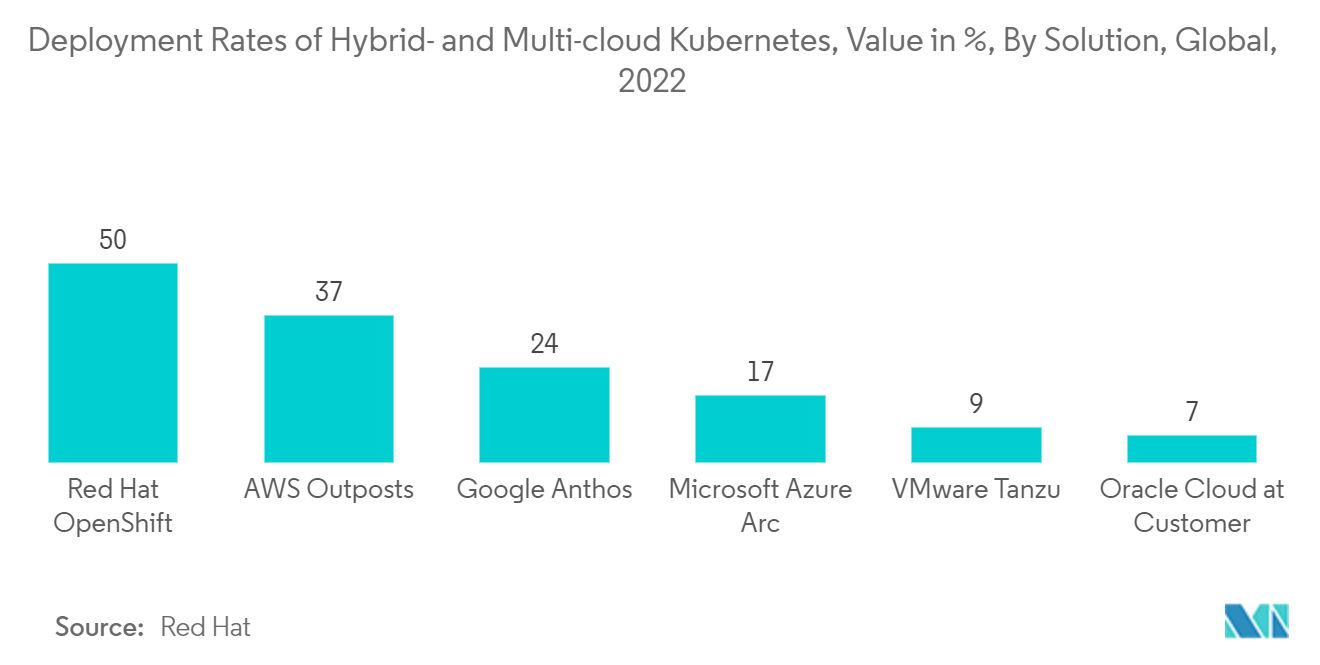
North America is Expected to Hold a Significant Market Share
- North America comprises some of the leading countries, such as the United States and Canada, that are expected to have a significant market share in the container security market due to the ongoing technological advancements across the region with solid regulations for multiple end-user verticals.
- The affordability and ease of deployment of container services among enterprises across the region are driving the adoption of container security across the region. Further, the adoption of cloud-based technologies by enterprises across the region is growing significantly. Furthermore, they incur lower maintenance costs and include remote access along with built-in security features.
- Moreover, businesses in the United States are utilizing containers more often to streamline their application workflow procedures. Many have switched to container services and solution providers to help them get the most out of this cloud-native technology. Numerous business organizations in the nation are using and utilizing containers. In some cases, companies are looking to increase their container resources internally by training staff in technology or hiring seasoned engineers. In contrast, in other cases, the firms turn to service providers for assistance in scaling up their container operations.
- Furthermore, the presence of prominent market players and the emergence of artificial intelligence-based applications across significant sectors are the primary factors driving market expansion in this area. These trends are expected to continue in the years to come.
- The ongoing trends in cloud computing, such as hybrid cloud solutions, cloud security, and cloud services and solutions such as SaaS, PaaS, and IaaS across the region, are expected to increase significantly, thereby boosting market growth.
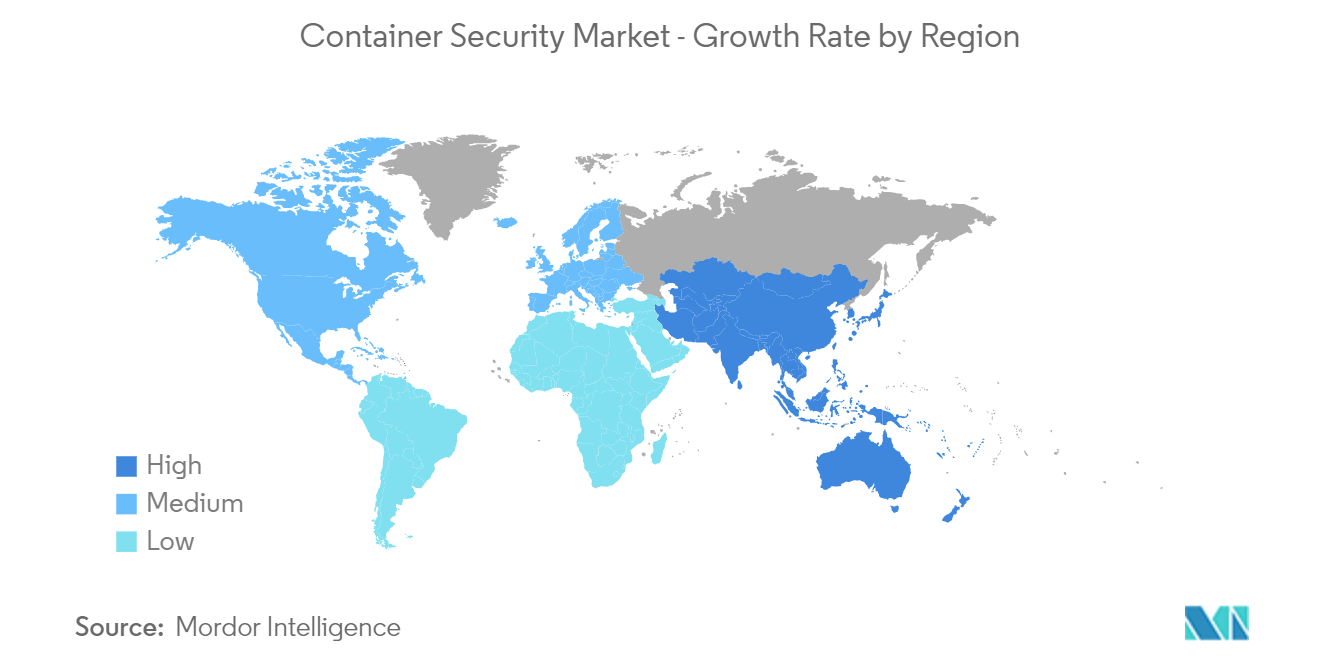
Container Security Industry Overview
The container security market is moderately competitive and consists of a few significant players. In terms of market share, some of the players, such as Google LLC, Trend Micro Incorporated, Qualys Inc., Aqua Security Software Ltd., Twistlock Ltd., etc., currently hold a significant share in the market. However, with the ready security and compliance platform advancement across hybrid IT environments, new players are increasing their market presence, thereby expanding their business footprint across emerging economies.
In October 2022, NeuVector, a developing business specializing in full-lifecycle container security, was acquired by SUSE, a firm specializing in enterprise-level open-source solutions. The distribution of more than 695,000 additional shares and SUSE's cash balance equal USD 130 million, which goes toward the acquisition. By acquiring NeuVector, SUSE would improve its value offer for secure software and provide its clients access to a more efficient container security program.
In February 2022, the integration of Sysdig Secure with Snyk Container, which includes container security from development to operations, was announced by Sysdig, the industry player in unified container and cloud security, and Snyk, a market player in developer security. Based on preliminary internal testing, this integration enables teams to use runtime intelligence from Sysdig Secure with Snyk Container to remove up to 95% of vulnerability alarms. Through their collaboration, Sysdig and Snyk provide the first integration across developer, DevOps, and SecOps silos by bringing together the container runtime and developer security tools.
Container Security Market Leaders
-
Google LLC
-
Trend Micro Incorporated
-
Qualys Inc.
-
Aqua Security Software Ltd.
-
Red Hat, Inc.
*Disclaimer: Major Players sorted in no particular order
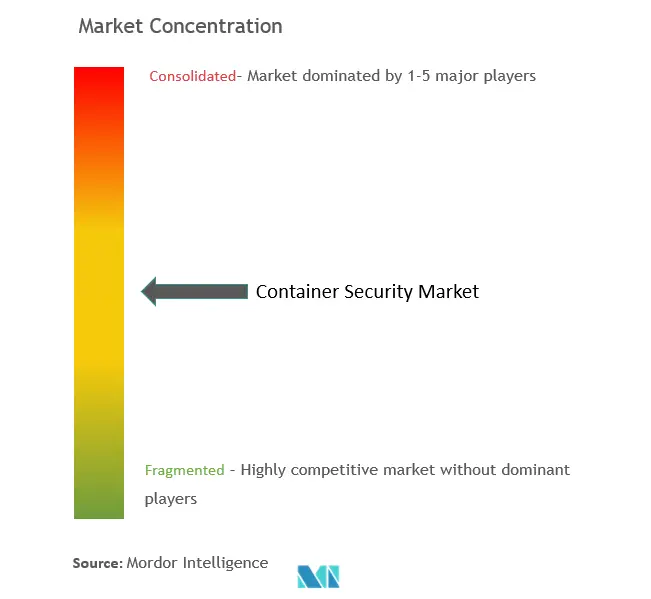
Container Security Market News
- October 2022: Veracode, a prominent global supplier of application security testing solutions, announced the addition of container security to its Continuous Software Security Platform. Existing clients can now participate in the Veracode Container Security early access program. The new Veracode Container Security service addresses the need for vulnerability scanning, secure configuration, and secrets management for container images.
- August 2022: Tigera, which offers an active Cloud-Native Application Protection Platform (CNAPP) in the industry with full-stack observability for containers and Kubernetes, announced the General Availability (GA) of its new container security features. These features include malware protection during runtime, Image Assurance with container image scanning, runtime visibility of vulnerable workloads, and admission control policies. With the inclusion of these features in Calico Cloud, clients now have access to a single container security solution that can strengthen security posture, lower attack surfaces with fine-grained security controls, and offer threat prevention against host and network-based attacks.
Container Security Market Report - Table of Contents
1. INTRODUCTION
- 1.1 Study Assumptions and Market Definition
- 1.2 Scope of the Study
2. RESEARCH METHODOLOGY
3. EXECUTIVE SUMMARY
4. MARKET INSIGHTS
- 4.1 Market Overview
- 4.2 Industry Value Chain Analysis
-
4.3 Industry Attractiveness - Porter's Five Forces Analysis
- 4.3.1 Bargaining Power of Suppliers
- 4.3.2 Bargaining Power of Buyers/Consumers
- 4.3.3 Threat of New Entrants
- 4.3.4 Threat of Substitute Products
- 4.3.5 Intensity of Competitive Rivalry
- 4.4 Assessment of the Impact of COVID-19 on the Market
5. MARKET DYNAMICS
-
5.1 Market Drivers
- 5.1.1 Rising Adoption of the Hybrid Cloud Technology Applications
- 5.1.2 Growing Vulnerability Concern across the Container Architecture
-
5.2 Market Restraints
- 5.2.1 Complexity in Managing the Cloud Environments
- 5.2.2 Inadequate Budgets in SMEs and Lack of Technical Expertise
- 5.3 Technology Snapshot
6. MARKET SEGMENTATION
-
6.1 By Organisation Size
- 6.1.1 Large Enterprises
- 6.1.2 Small & Medium Enterprises
-
6.2 By Deployment
- 6.2.1 Cloud-based
- 6.2.2 On-premise
-
6.3 By End-user Industry
- 6.3.1 IT & ITES
- 6.3.2 BFSI
- 6.3.3 Retail
- 6.3.4 Healthcare
- 6.3.5 Industrial
- 6.3.6 Other End-user Industries
-
6.4 Geography
- 6.4.1 North America
- 6.4.1.1 United States
- 6.4.1.2 Canada
- 6.4.2 Europe
- 6.4.2.1 United Kingdom
- 6.4.2.2 Germany
- 6.4.2.3 Rest of Europe
- 6.4.3 Asia-Pacific
- 6.4.3.1 China
- 6.4.3.2 Japan
- 6.4.3.3 Rest of Asia-Pacific
- 6.4.4 Rest of the World
- 6.4.4.1 Latin America
- 6.4.4.2 Middle-East & Africa
7. COMPETITIVE LANDSCAPE
-
7.1 Company Profiles
- 7.1.1 Google LLC (Alphabet Inc.)
- 7.1.2 Trend Micro Incorporated
- 7.1.3 Qualys Inc.
- 7.1.4 Red Hat, Inc.
- 7.1.5 Palo Alto Networks Inc.
- 7.1.6 Aqua Security Software Ltd.
- 7.1.7 Rapid7, Inc.
- 7.1.8 Mirantis, Inc. (Docker, Inc.)
- 7.1.9 NeuVector Inc. (SUSE Software Solutions Germany GmbH)
- 7.1.10 Thales eSecurity (Thales Group)
- 7.1.11 Fidelis Cybersecurity, Inc.
- *List Not Exhaustive
8. INVESTMENT ANALYSIS
9. MARKET OPPORTUNITIES AND FUTURE TRENDS
** Subject To AvailablityContainer Security Industry Segmentation
Container security can be defined as the process of putting security tools and procedures in place to offer comprehensive information security for any workload or system based on containers, including the container image, the operating container, and all the actions necessary to produce the image and get it running. The market for the study defines the revenue generated from the sales of the security cloud solutions across various end-users, including IT & ITES, BFSI, Retail, Healthcare, and Industrial, etc.
The Container Security Market is segmented by Organization Size (Large Enterprises, Small & Medium Enterprises), Deployment (Cloud-based, On-premise), End-user Industry (IT & ITES, BFSI, Retail, Healthcare, and Industrial), and Geography (North America, Europe, Asia-Pacific, and Rest of the World).
The market sizes and forecasts are provided in terms of value (USD million) for all the above segments.
| By Organisation Size | Large Enterprises | |
| Small & Medium Enterprises | ||
| By Deployment | Cloud-based | |
| On-premise | ||
| By End-user Industry | IT & ITES | |
| BFSI | ||
| Retail | ||
| Healthcare | ||
| Industrial | ||
| Other End-user Industries | ||
| Geography | North America | United States |
| Canada | ||
| Geography | Europe | United Kingdom |
| Germany | ||
| Rest of Europe | ||
| Geography | Asia-Pacific | China |
| Japan | ||
| Rest of Asia-Pacific | ||
| Geography | Rest of the World | Latin America |
| Middle-East & Africa |
Container Security Market Research FAQs
How big is the Container Security Market?
The Container Security Market size is expected to reach USD 3.28 billion in 2024 and grow at a CAGR of 22.54% to reach USD 9.07 billion by 2029.
What is the current Container Security Market size?
In 2024, the Container Security Market size is expected to reach USD 3.28 billion.
Who are the key players in Container Security Market?
Google LLC, Trend Micro Incorporated, Qualys Inc., Aqua Security Software Ltd. and Red Hat, Inc. are the major companies operating in the Container Security Market.
Which is the fastest growing region in Container Security Market?
Asia-Pacific is estimated to grow at the highest CAGR over the forecast period (2024-2029).
Which region has the biggest share in Container Security Market?
In 2024, the North America accounts for the largest market share in Container Security Market.
What years does this Container Security Market cover, and what was the market size in 2023?
In 2023, the Container Security Market size was estimated at USD 2.68 billion. The report covers the Container Security Market historical market size for years: 2019, 2020, 2021, 2022 and 2023. The report also forecasts the Container Security Market size for years: 2024, 2025, 2026, 2027, 2028 and 2029.
Container Security Software Industry Report
Statistics for the 2024 Container Security Software market share, size and revenue growth rate, created by Mordor Intelligence™ Industry Reports. Container Security Software analysis includes a market forecast outlook to 2029 and historical overview. Get a sample of this industry analysis as a free report PDF download.



